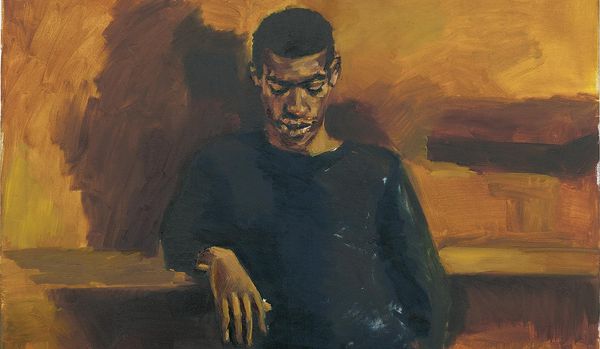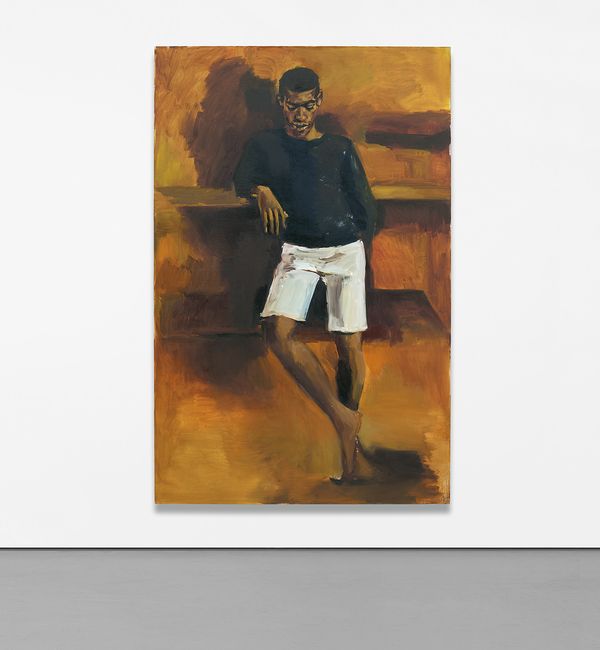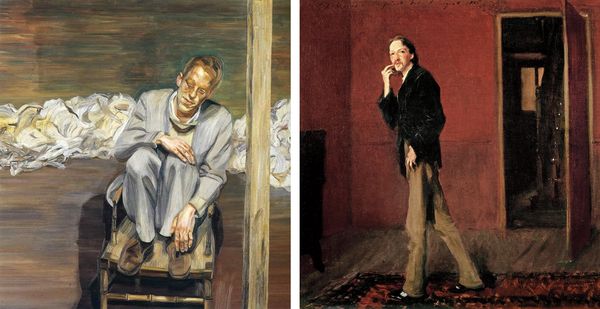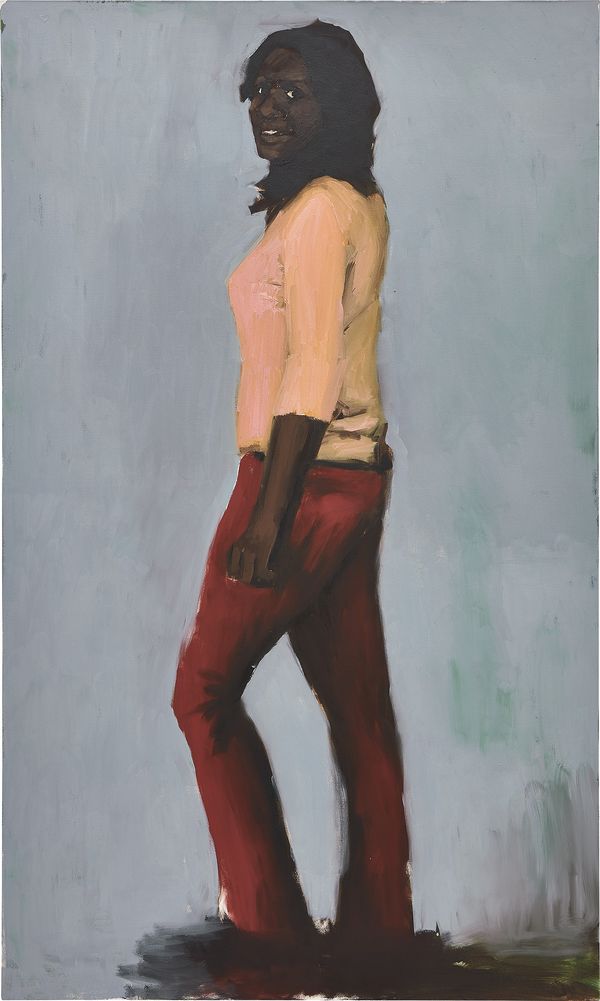Detail from Lynette Yiadom-Boakye Leave A Brick Under The Maple, 2015
Presented on a life-size scale, Leave A Brick Under The Maple, 2015, is a sumptuous painting that exemplifies Lynette Yiadom-Boakye's distinctively raw and poised style of portraiture. Delineating the elegant silhouette of a young man leaning against an indeterminate backdrop, the composition spans varying shades of terracotta and brown, and captures the painted protagonist in a liminal, peaceful state that places him between transitional sleep and conscious restfulness. Concurrently, the figure’s phosphorescent white trousers produce a potent effect of contrast which enhances the impressions of depth and light in the painting, allowing him to emerge from the surface of the canvas and step into the real world. Created the same year as her significant solo show at the Serpentine Gallery, London, and on the heels of her contribution to the 55th Venice Biennale in 2013, Leave A Brick Under The Maple stands as a potent proclamation of Yiadom-Boakye’s cornerstone status in today's generation of figurative painters.
Maybe I think more about black thought than black bodies.
— Lynette Yiadom-Boakye
Painted in 2015, the work stands at 200 x 130 cm (78 3/4 x 51 1/8 in.) tall.
Achieved with loose, expressive brushstrokes and deftly painted fields of opulent color, Leave A Brick Under The Maple exudes a sense of transience that echoes the fleeting touch of the artist's particular painting technique. Known to complete her canvases in a single day, Yiadom-Boakye optimizes the malleability of the oil paint while it is still fresh, conjuring a tangible, intuitive image that sometimes lets elements "happen in the painting itself" (Lynette Yiadom-Boakye, ‘Lynette Yiadom-Boakye’s Fashionable Eye’, The New York Times, November 2010). Continuing a dialogue with pioneering protagonists of portraiture, she draws on traditional painterly methods ranging from the Old Masters' sophisticated use of chiaroscuro, to Paul Cézanne's allusive forms of verisimilitude. However, the artist’s key refusal of named identities and sitters distinguishes her from her forebears; in the present painting, the young man portrayed can only be individualized through the viewer's sustained gaze and imaginative projection.
From left: Lucian Freud Red Haired Man on a Chair, 1962-1963, oil on canvas. © The Lucian Freud Archive / Bridgeman Images. John Singer Sargent Robert Louis Stevenson and His Wife, 1885, oil on canvas, The Metropolitan Museum of Art. Image: Bridgeman Images.
Presenting a subject that is at once familiar and foreign – a deeply literary collision – Leave A Brick Under The Maple engages the viewer's eye and mind, acting as a generative source for narrative projection. As such, it is representative of Yiadom-Boakye’s enthrallingly enigmatic visual repertoire, which continuously asks of its audience to find references both internally and externally, from a long list of art historical precedent or from an unknowably unique history of intimate experiences. Culled from sources both personal and academic, Yiadom-Boakye's imagery indeed spans a variety of realms, including academic allusions, found images, and the unknowably graceful realm of dance. Her painterly portraits eschew the physical reality of her models' bodies and instead introduce "suggestions of people [who] don't share our concerns or anxieties": imaginary individuals who are "somewhere else altogether" (Lynette Yiadom-Boakye, ‘Lynette Yiadom-Boakye’s Fashionable Eye’, The New York Times, November 2010). Beguilingly suggestive and irreducibly atmospheric, they are akin to character studies for people who don't exist (Zadie Smith, ‘Lynette Yiadom-Boakye’s Imagined Portraits’, The New Yorker, June 2017).
Lynette Yiadom-Boakye Marble, 2010. Sold for £369,000 in October 2018 during our London 20th Century & Contemporary Art Evening Sale.
Resonating with Yiadom-Boakye’s concurrent background as a writer, Leave A Brick Under The Maple demonstrates the artist's claim that "I write about the things I can't paint and paint the things I can't write about" (Zadie Smith, The New Yorker). Clearly able to summon human sensibility with both a pen and a paintbrush, the artist paints without the help or presence of real models, instead sourcing images from amalgamated thoughts and ideas – the same conglomerate hub that allows her to write. The man portrayed in Leave A Brick Under The Maple exemplifies this kind of commanding yet mystifying portraiture; he is both here and there – embodying an interiority rather than a physical body.
Auguste Rodin The Age of Bronze, 1875-1876, bronze, Cleveland Museum of Art. Image: Bridgeman Images.
Presented as the second lot in our 20th Century & Contemporary Art Evening Sale in London, Leave A Brick Under The Maple beautifully encapsulates Yiadom-Boakye’s poetic practice: it presents a human figure that brims with internal complexities despite physical immobility. "When I think of the figure, I think of immortality or an otherness that is just out of this world, representing an endless possibility", she has said (Lynette Yiadom-Boakye, Interview Magazine). Conjuring a number of evident painterly and literary associations, including the sizeable legacy of classical European portraiture, Leave A Brick Under The Maple also more subtly alludes to the sculptural manifestations of posing bodies. In the present painting, the portrayed character is one of brazen beauty, redolent of the classical heroes sculpted by the likes of Auguste Rodin. He eschews the flatness of the picture plane and instead flirts with three-dimensionality, providing riveting impressions of presence and movement. In turn, the entire composition transforms into a scene in motion, exuding an arresting sense of boundlessness.




